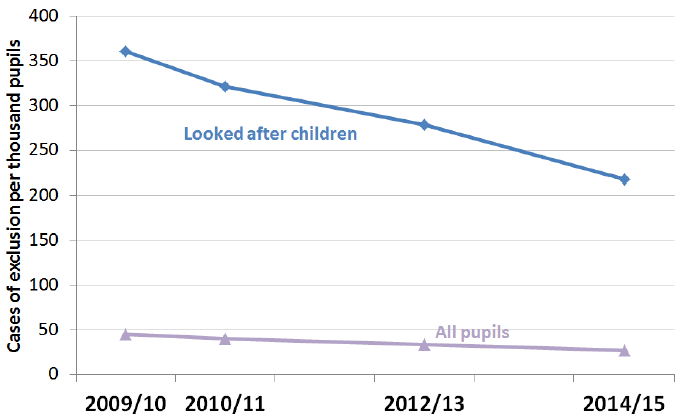Education outcomes for looked after children: 2014-2015
This publication links school and social work data to present information on the attainment, post-school destinations of looked after young people who leave school, and the school attendance and exclusion rates of all looked after children.
This document is part of a collection
School exclusions of looked after children

In comparison with the general school population, this section presents data on the numbers and rates of exclusions of the 654 looked after children at publically-funded schools who were successfully linked to schools data, and who experienced an exclusion. Exclusions data is now only collected every two years, so the information for 2011/12 and 2013/14 is not available.
Table 4.1 shows the total number and rate of exclusions. As children can be excluded more than once per year they will be counted more than once in these figures. The rate of exclusions among looked after children is much higher than in the general school population (218 cases per 1,000 looked after pupils, compared to 27 per 1,000 in the general school population), and is falling at a similar rate. However, the absolute fall in the rates of exclusions for looked after children is much greater, but they are coming from a much worse position.
Table 4.1: Exclusion rate per 1,000 pupils by all pupils, looked after children and stage, 2009/10 to 2014/15
| Stage | 2009/10 | 2010/11 | 2012/13 | 2014/15 |
|---|---|---|---|---|
| Looked after full year | ||||
| Primary | 122 | 95 | 83 | 79 |
| Secondary | 632 | 584 | 476 | 322 |
| Special | 591 | 455 | 576 | 569 |
| Scotland | 360 | 321 | 279 | 218 |
| All pupils | ||||
| Primary | 12 | 11 | 10 | 9 |
| Secondary | 82 | 72 | 58 | 50 |
| Special | 174 | 148 | 148 | 126 |
| Scotland | 45 | 40 | 33 | 27 |
As seen in chart 5, looked after children are showing a continuing decline in the rate of exclusions, the declines are comparable in proportion to those in the overall population, although they look much more impressive as they started from a much worse position.
Chart 5 Exclusion rate per 1,000 pupils by all pupils, looked after children, 2009/10 to 2014/15

Where Table 4.1 presents data on the total number of exclusions, including potential multiple counts of the same child, Table 4.2 presents data on the total number of children excluded, resulting in lower figures. In both groups, the rate of exclusions is four to five times greater in secondary schools compared to primary schools.
Table 4.2: Number of different pupils excluded and exclusion rate per 1,000 pupils by all pupils, looked after children and sector, 2014/15
| Stage | Number of pupils excluded | Rate per 1,000 pupils |
|---|---|---|
| Looked after children | ||
| Primary | 119 | 36 |
| Secondary | 452 | 150 |
| Special | 91 | 228 |
| All Pupils | ||
| Primary | 1,890 | 5 |
| Secondary | 8,176 | 29 |
| Special | 380 | 56 |
Accommodation type
Table 4.3: Cases of exclusions for looked after children, by accommodation type, 2014/15 (1),(2)
| Single Type of Accommodation | Total exclusions for looked after children | Exclusions per 1,000 pupils who were looked after |
|---|---|---|
| In the community | ||
| At home with parents | 299 | 261 |
| With friends/relatives | 236 | 141 |
| With foster carers provided by LA | 169 | 109 |
| With foster carers purchased by LA | 104 | 135 |
| In other community (1) | 2 | 125 |
| Residential Accommodation | ||
| In local authority home | 131 | 891 |
| In voluntary home | 34 | 810 |
| In residential school | 0 | - |
| In other residential (2) | 15 | 246 |
| Unknown/Multiple placements | 463 | 370 |
| Total looked after children | 1,453 | 218 |
(1) Includes 'with prospective adopters'.
(2) Includes 'in secure care accommodation' and 'crisis care'.
As with attendance, there is a similar disparity between types of accommodation in the rates of exclusions. Those children in residential accommodation tend to have higher rates of exclusions than looked after in the community. Children looked after at home have a noticeably higher exclusion rate than others looked after in the community (Table 4.3).
There is a tendency for looked after children with a greater number of placements to have a higher rate of exclusions. Clearly the number of placements experienced has a strong influence on the rate of exclusions.
Table 4.4: Cases of exclusions for looked after children, by number of placements, 2014/15
| Number of placements | Total exclusions | Exclusions per 1,000 pupils who were looked after |
|---|---|---|
| 1 | 990 | 182 |
| 2 | 259 | 301 |
| 3 | 148 | 536 |
| 4 | 29 | 403 |
| 5 or more | 27 | 628 |
| Scotland | 1,453 | 218 |
Contact
There is a problem
Thanks for your feedback